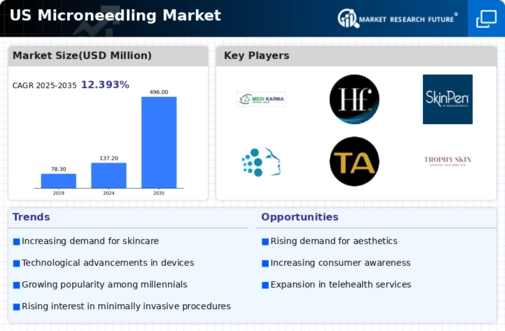Expansion of Aesthetic Clinics and Spas
The proliferation of aesthetic clinics and spas across the US is a significant driver for the microneedling market. As more establishments offer specialized skincare services, access to microneedling treatments is becoming increasingly convenient for consumers. This expansion is often accompanied by promotional offers and package deals, making treatments more appealing. Additionally, the rise of medical spas, which combine medical expertise with a spa-like environment, is likely to enhance consumer trust in microneedling procedures. This trend could lead to a broader acceptance of microneedling as a standard treatment option in aesthetic practices.
Increasing Demand for Non-Invasive Procedures
The microneedling market is experiencing a notable surge in demand for non-invasive cosmetic procedures. Consumers are increasingly seeking alternatives to surgical interventions, favoring treatments that offer minimal downtime and reduced risk. This trend is particularly pronounced among younger demographics, who are more inclined to invest in skin rejuvenation techniques. According to recent data, the non-invasive aesthetic procedures market in the US is projected to grow at a CAGR of approximately 10% over the next five years. This growth is likely to bolster the microneedling market, as it aligns with consumer preferences for effective yet less invasive solutions.
Growing Awareness of Skin Health and Aesthetics
There is a rising awareness among consumers regarding skin health and aesthetics, which is significantly impacting the microneedling market. Educational campaigns and social media influence have heightened public interest in skincare treatments. As individuals become more informed about the benefits of microneedling, including improved skin texture and reduced scarring, the demand for these services is likely to increase. Market data suggests that the skincare industry in the US is valued at over $80 billion, with a substantial portion attributed to minimally invasive treatments. This trend indicates a promising future for the microneedling market as consumers prioritize skin health.
Technological Advancements in Microneedling Devices
Technological innovations are playing a pivotal role in shaping the microneedling market. The introduction of automated and motorized devices has enhanced the precision and efficacy of treatments, leading to improved patient outcomes. These advancements not only increase the safety of procedures but also reduce the time required for treatments. Furthermore, the integration of advanced features such as adjustable needle depth and real-time feedback mechanisms is likely to attract more practitioners to adopt microneedling techniques. As a result, the market is expected to witness a significant uptick in device sales, contributing to overall market growth.
Influence of Social Media and Celebrity Endorsements
Social media platforms and celebrity endorsements are exerting a considerable influence on the microneedling market. The visibility of microneedling treatments on platforms like Instagram and TikTok has contributed to a growing trend among consumers seeking similar results. Influencers and celebrities often share their positive experiences, which can significantly sway public perception and increase demand. This phenomenon is particularly relevant in the beauty industry, where visual appeal is paramount. As a result, the microneedling market may continue to benefit from this trend, as more individuals seek to replicate the aesthetic outcomes showcased online.




















Leave a Comment